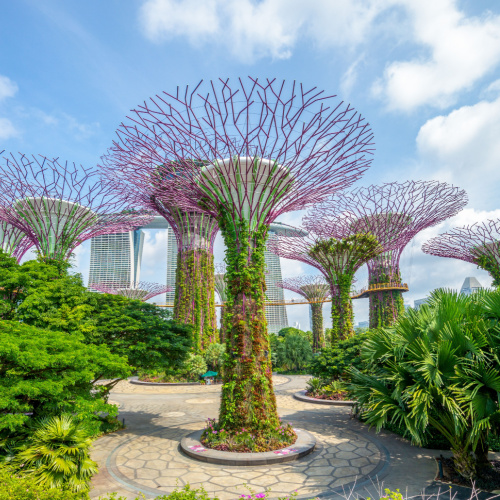
Richie Chan/Shutterstock
When Is the Best Time to Visit Singapore?
The best time to visit Singapore is during the shoulder seasons of February to April and October to November. During these months, the weather is generally mild and sunny, with fewer crowds and lower prices than during the peak summer season of May to June and the peak tourist season of December to January.
Here are some of the benefits of visiting Singapore during the shoulder seasons:
- Mild weather: Singapore has a tropical climate with hot and humid weather year-round. However, the shoulder seasons offer slightly cooler temperatures and less humidity, making it more comfortable to be outdoors and enjoy all that Singapore has to offer.
- Smaller crowds: The shoulder seasons are less crowded than the peak summer and tourist seasons, so you’ll be able to enjoy Singapore’s popular attractions without having to deal with large crowds. This is especially important if you’re visiting popular attractions like Gardens by the Bay, Marina Bay Sands, and Universal Studios Singapore.
- Lower prices: Prices for flights, accommodation, and activities are generally lower during the shoulder seasons than during the peak summer and tourist seasons. This means you can save money on your trip without having to sacrifice quality.
Here are some specific examples of how you can enjoy the most of Singapore during the shoulder seasons:
- February to April: The weather in February to April is typically sunny and warm, with occasional showers. This is a great time to visit for sightseeing in the city center, exploring the many parks and gardens, and attending the Singapore Food Festival.
- October to November: The weather in October to November is also typically sunny and warm, with occasional showers. This is a great time to visit for shopping at the Great Singapore Sale, attending the Formula 1 Singapore Grand Prix, and enjoying the cooler temperatures and lower humidity.
While there are many great times to visit Singapore, if you’re looking for the best weather, fewer crowds, and lower prices, then we recommend visiting during the shoulder seasons of February to April and October to November.
 Average Temperatures by Month
Average Temperatures by Month
|
Jan |
Feb |
Mar |
Apr |
May |
Jun |
Jul |
Aug |
Sep |
Oct |
Nov |
Dec |
| Fahrenheit |
86°
|
87°
|
88°
|
89°
|
88°
|
87°
|
87°
|
87°
|
87°
|
87°
|
87°
|
86°
|
| Celsius |
30°
|
31°
|
31°
|
32°
|
31°
|
30°
|
31°
|
31°
|
30°
|
30°
|
30°
|
30°
|
Climate in Singapore
Summer Season in Singapore
Given its equatorial location, Singapore experiences a summer-like climate throughout the year. Characterized by consistent warm temperatures averaging around 31°C (88°F), high humidity, and occasional afternoon thunderstorms, the weather is generally sunny and hot. This consistent climate makes Singapore suitable for year-round travel, though outdoor activities are often best enjoyed in the mornings or late afternoons to avoid the midday heat.
Rainy Season in Singapore
The rainy season in Singapore, influenced by the Northeast Monsoon, brings more frequent and heavier rainfall, usually in the form of short, intense showers, often occurring in the afternoon or early evening. Despite the increase in rain, temperatures remain warm and the climate humid. This season is also characterized by calmer sea conditions and less haze.
Winter Season in Singapore
Singapore does not experience a traditional winter season with cold weather. The closest to 'winter' would be the cooler part of the rainy season, where the temperatures are slightly lower, and the rainfall is more frequent, but the climate remains warm and humid. The concept of winter, as understood in temperate regions, does not apply to Singapore's tropical climate.
Our Recommendations
| Destination |
Jan |
Feb |
Mar |
Apr |
May |
Jun |
Jul |
Aug |
Sep |
Oct |
Nov |
Dec |
| Singapore |
 |
 |
 |
 |
 |
 |
 |
 |
 |
 |
 |
 |






